
There are many articles and essays about new archaeology finds that are of interest to modern Pagans, Heathens, and polytheists out there, more than our team can write about in-depth in any given week, and the last few weeks have been very busy! Therefore, The Wild Hunt must unleash the hounds in order to round them all up. Here are our favorite picks this month.
MEXICO – Archeologists have unearthed an ancient stone “scoreboard” likely used during a game that was one of soccer’s predecessors. Archaeologists and researchers from Mexico’s National Institute of Anthropology and History (INAH) discovered an engraved disc that presents two ball players in the center; It has a diameter of 32.5 centimeters, 9.5 cm. thick and 40 kg. of weight, the finding was made in Chichén Itzá, Yucatan, a UNESCO World Heritage Site and one of the main archaeological centers of the Mayan civilization. Researchers believe the object dates to between 800 CE and 900 CE. “In this Mayan site, it is rare to find hieroglyphic writing, let alone a complete text,” said Francisco Perez, one of the archaeologists coordinating the investigation told Reuters. The stone depicts two figures in the center, with Mayan hieroglyphic writing bounding the outer edge. One figure is wearing a feathered headdress, and the other figure-, who is presumably the opponent – wears a snake-like headpiece that was reserved for high-ranking members of Mayan society. Experts continue to analyze the object as they prepare it for conservation.
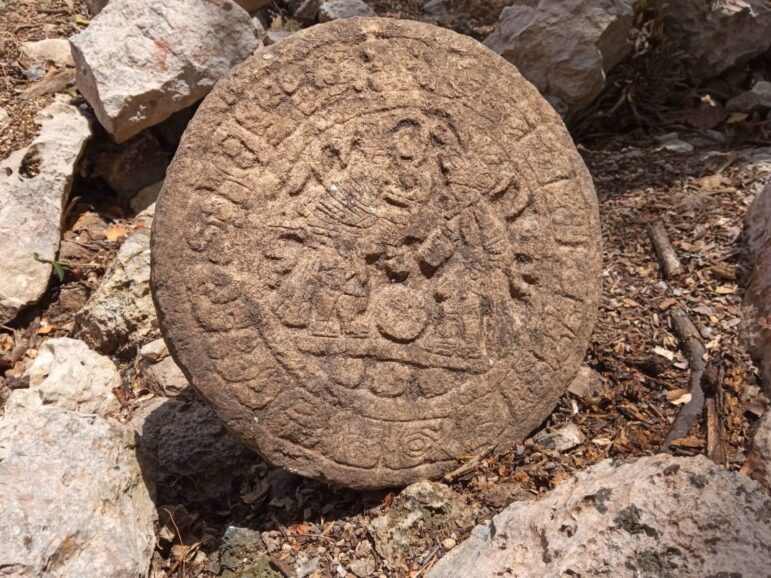
Mexican archaeologists found a circular-shaped Mayan scoreboard at Chichen Itza’s archaeological site [Image credit: National Institute of Anthropology and History (INAH)]
FRANCE – Archaeologists from the National Institute of Preventive Archaeological Research (INRAP) excavating in Brittany announced the discovery of a temple to the Roman war god Mars. The temple dates to around the first century CE. The temple is part of a larger Roman complex that encompasses 7 hectares (about 17 acres) in the modern town of La Chapelle-des-Fougeretz a few miles northwest of Rennes, a region well-known for its prized archeological findings since the 1970s. Excavation began at the current site in 1990. The latest find includes iron weapons and some terracotta figurines of Venus and other yet-to-be-identified goddesses. The temple complex appears to have some 40 tombs as well as public baths. The tombs themselves held additional including silver coins, pins, and jewelry.
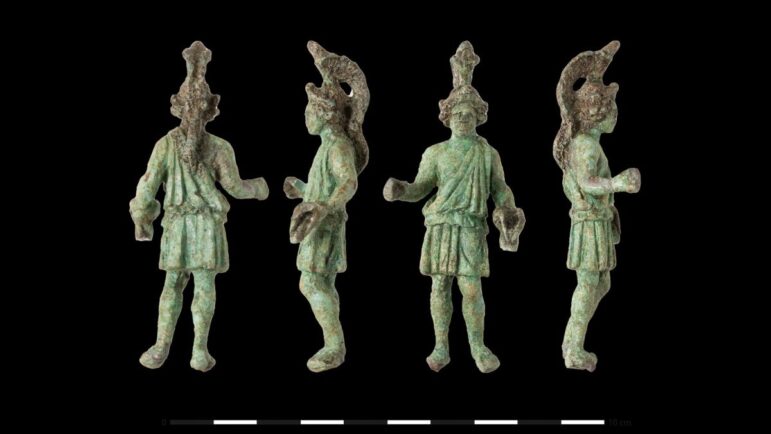
The discovery bronze figurine of the Roman war god Mars suggests he was worshipped at the La Chapelle-des-Fougeretz site. (Image credit Emmanuelle Collado, INRAP)
One of the tombs had a dagger and a horse harness. The archeologists wrote in a statement “Among these funerary deposits: glass and ceramic vases, but also shoes of which only the studded soles remain. Some tombs were more richly endowed with silver adornments (bracelets, pins, and belt buckles), as well as glass beads. The richest tomb, probably containing the burial of a man, yielded a dagger and elements belonging to a horse harness. Among them, were an iron bit and numerous bronze appliqués which were to decorate the bridle and the reins. These objects make it possible to date the necropolis to the end of Antiquity, between the 4th century and the 5th century of our era.” The temple itself may have been the central temple site for the region. Brittany would have been an important launching point for Rome as it moved north into the British Isles. The region was called Armorica during the period of Roman occupation. Brittany, or Breizh, also retains one of the surviving Celtic languages and is most closely related to Cornish. It is the Celtic language most widely in modern use on the European mainland but UNESCO lists the language as “severely endangered” with about 200,000 speakers, having declined from 1 million over the last five decades.
ITALY – Archeologists have found a statue of the god Eros riding a dolphin said Italian culture ministry officials on Saturday, April 15, 2023. They said the find informs us more about religious life and its rituals in the ancient city of Paestum, about twenty miles south of modern-day Salerno on southern Italy’s Amalfi coast. Paestum was a major ancient Greek city in the region of Magna Graecia, now the southern Italian peninsula. Paestum is famed for its three ancient Greek temples in the Doric order, dating from about 550 BCE to 450 BCE that remain in an outstanding state of preservation. Romans controlled the city in 275 BCE renaming it Paestum from the Greek “Poseidonia.”
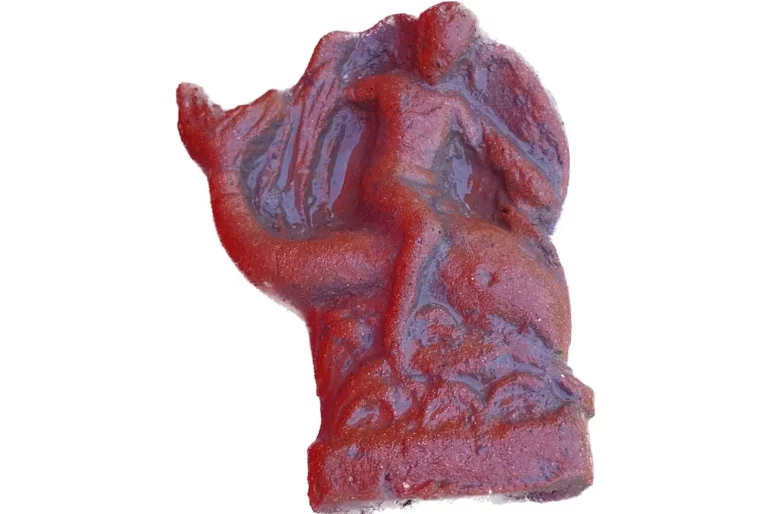
A terracotta figurine of Eros riding a dolphin was found in a newly discovered temple site in Paestum. [Image Credit: Archaeological Park of Paestum and Velia]
The Eros figurine was found in a new small temple identified in 2019 but additional excavations were halted due to the COVID-19 pandemic. When excavations resumed, the Italian Culture Ministry said the site yielded artifacts in the first few months. Among them were several small terracotta figurines and seven bulls’ heads at the temple altar arranged in a devotional manner. The dolphin statue was among the finds. The figure might be attributed to a specific family of ceramicists, the Avili, whose work has been documented elsewhere but not a Paestum. Images of Eros riding a dolphin have been found elsewhere most famously in a mosaic at Bulla Regia in Jendouba, Tunisia.
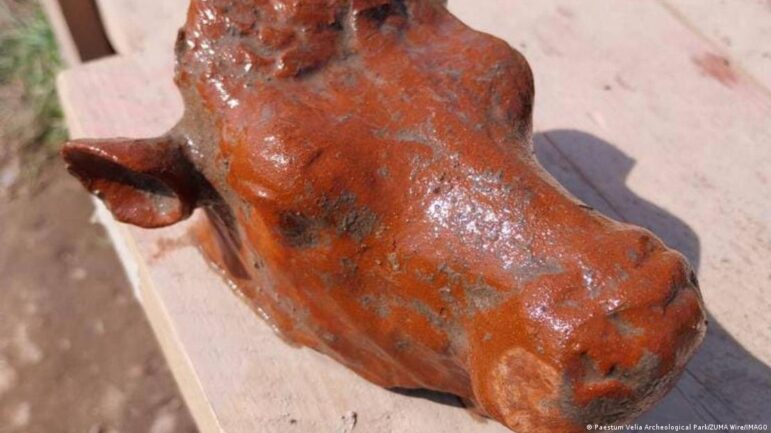
One of the seven bulls’ heads found at Paestum [Image credit: Archaeological Park of Paestum and Velia]
UK – A ring dating to the second century was uncovered near Chelmsford in Essex by a metal detectorist and bears the image of Apollo carved in carnelian. Researchers believe the ring may be part of the Snettisham hoard which included 110 unmounted carved gemstones used as seals or intaglios, silver jewelry, and ingots, and 110 coins and tools, all of which are currently at the British Museum.
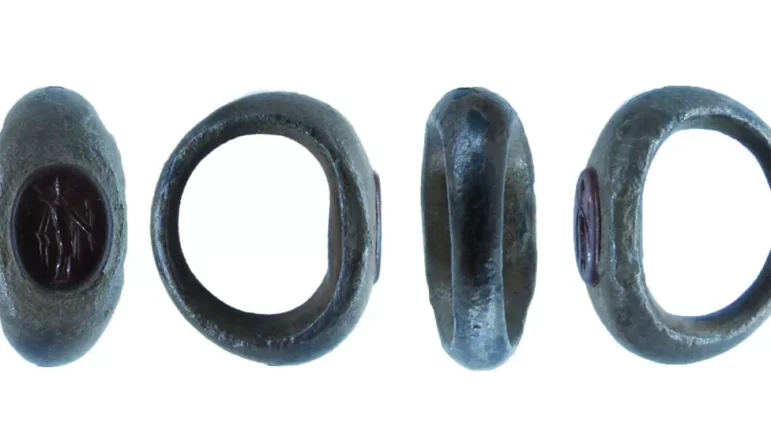
The silver ring’s carved gemstone is a dark orange-red colour and is probably a carnelian [Image credit: Colchester and Ipswich Museum]
Rings like the one found in Chelmsford would have been used to sign and seal documents but could have also had a very personal value. Lori Rogerson, the Essex finds liaison explained, “We know these people would have had a very close personal relationship with their gods and goddesses. Apollo, being the god of healing and prophecy, would hopefully have protected the wearer from harm or illness. It’s also really interesting because it’s evidence of a pagan religion that has its roots in Ancient Greece being worshipped by Romano-British society.”
The Wild Hunt is not responsible for links to external content.
To join a conversation on this post:
Visit our The Wild Hunt subreddit! Point your favorite browser to https://www.reddit.com/r/The_Wild_Hunt_News/, then click “JOIN”. Make sure to click the bell, too, to be notified of new articles posted to our subreddit.
